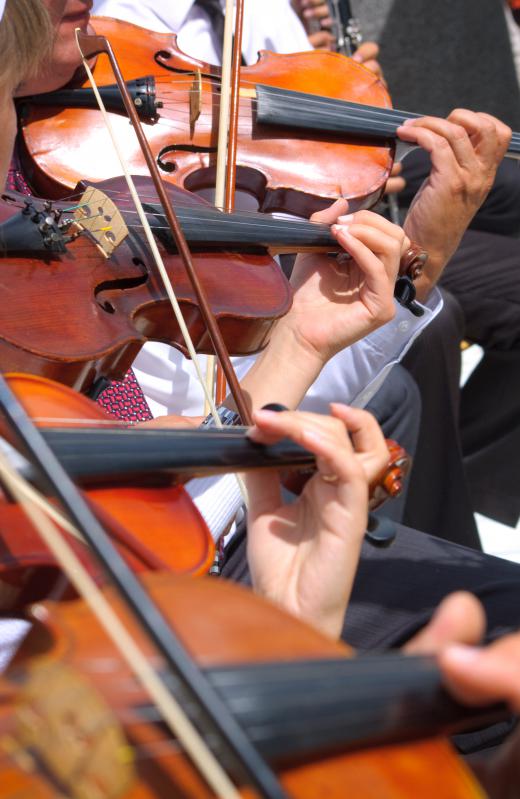At MusicalExpert, we're committed to delivering accurate, trustworthy information. Our expert-authored content is rigorously fact-checked and sourced from credible authorities. Discover how we uphold the highest standards in providing you with reliable knowledge.
What Is the Difference between an Orchestra and Band?
Though closely related, orchestra and band refer to different ensembles of musicians, playing similar arrangemennts of music with different types of instruments. Bands are musical ensembles primarily composed of instruments requiring a person's "wind" to make them work, like brass and woodwinds, along with percussion support for an insistent rhythm. Orchestras, by contrast, include string instruments, either solely or in concert with many of the wind, brass and percussion instruments common to bands.
When an orchestra includes just stringed instruments, it is often referred to as a string orchestra. If many varied types of instruments are employed, the term symphony orchestra applies, with smaller ensembles referred to as chamber orchestras. Orchestras are usually seated on a stage while performing. Bands may either be seated or marching uniformly to choreographed routines that evolved from military traditions.

The standard string orchestra contains a section each of violas, violins, cellos and basses, often accompanied in the rear by a percussion section. The symphony orchestra often adds to this mix two other types of sections: woodwind instruments like the bassoon, saxophone, flute, oboe, clarinet and bass clarinet; and brass instruments like the trumpet, trombone, French horn and tuba. Bands will only include these latter sections, along with percussion, leaving the string instrumentation to the comfortably seated.

The types of music played by an orchestra and band may be the same or it may differ dramatically. Some music is arranged just for string orchestras, like famous symphonic work by Mozart or Brahms, or just for marching bands, like the marches of Sousa. Other compositions are made for orchestra and band alike, with the individual conductor deciding which musicians will perform which parts.

The goal of both the orchestra and band is achieving tonal balance and range for optimum musical clarity. Each is divided among instruments that carry different parts of a musical composition — from the low, lolling notes to high-pitched, trilling melodies. Rarely, if ever, will the two sound the same, though, since they are composed of such dramatically different-sounding instruments. Similar to the modern choir, which divides singers according to range — basses, tenors, altos and sopranos — the orchestra and band are divided among instruments that can achieve a certain voice in the overall arrangement.

No matter where it was formed and for what purpose, the modern band or orchestra has a proud historical foundation. Youngsters breaking free of societal traditions and parental clutches may form a band to express themselves through music. In churches and royal courts dating back to early civilizations, orchestras of various sizes were formed to accompany religious rituals as well as everyday life. The marching band can be found through several centuries associated with military and political traditions, including its use of signaling various conditions on the battlefield to commanders in the rear.
AS FEATURED ON:
AS FEATURED ON:















Discussion Comments
@Grivusangel -- And look at The Beatles. They brought in an orchestra to provide a lot of the music on the "Sgt. Peppers Lonely Hearts Club Band" album, so the band/orchestra definition certainly blurs, as it does with many of the Beatles' later songs. And then there's the Electric Light Orchestra, so there you go.
I think the more interesting question is what's the difference between a symphony and a philharmonic? I mean, it's the New York Philharmonic, but the Nashville Symphony. Is there a difference in anything but the nomenclature? I just think most people kind of instinctively know the difference between a band and an orchestra.
However, I think about producing something like a rock musical, like "Jesus Christ Superstar," where at least a small symphony orchestra *and* a rock band are necessary to present the music properly. Not every ensemble can do everything.
Post your comments